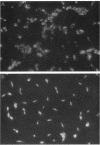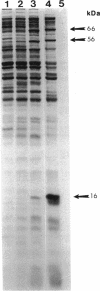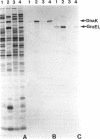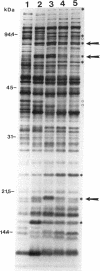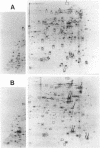Abstract
The response of exponentially growing cultures of Escherichia coli to abrupt shifts in hydrostatic pressure was studied. A pressure upshift to 546 atm (55,304 kPa) of hydrostatic pressure profoundly perturbed cell division, nucleoid structure, and the total rate of protein synthesis. The number of polypeptides synthesized at increased pressure was greatly reduced, and many proteins exhibited elevated rates of synthesis relative to total protein synthesis. We designated the latter proteins pressure-induced proteins (PIPs). The PIP response was transient, with the largest induction occurring approximately 60 to 90 min postshift. Fifty-five PIPs were identified. Many of these proteins are also induced by heat shock or cold shock. The PIP demonstrating the greatest pressure induction was a basic protein of 15.6 kDa. High pressure inhibits growth but does not inhibit the synthesis of stringently controlled proteins. Cold shock is the only additional signal which has been found to elicit this type of response. These data indicate that elevated pressure induces a unique stress response in E. coli, the further characterization of which could be useful in delineating its inhibitory nature.
Full text
PDF
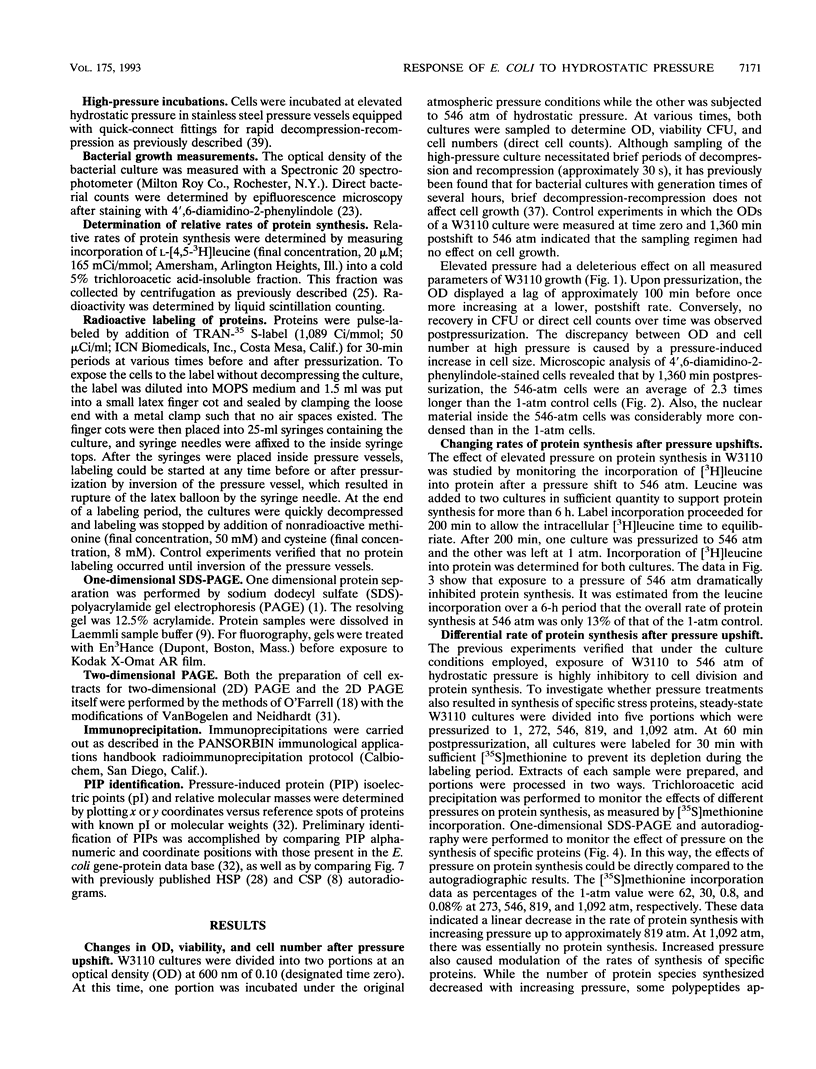
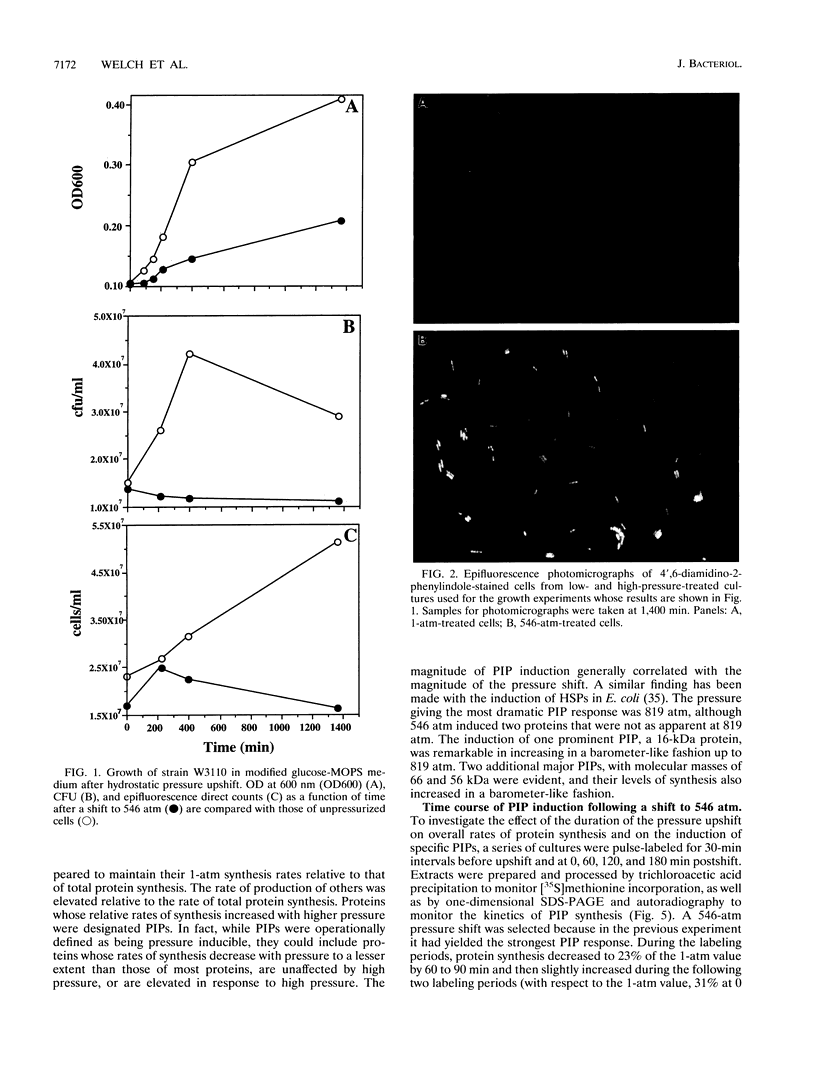
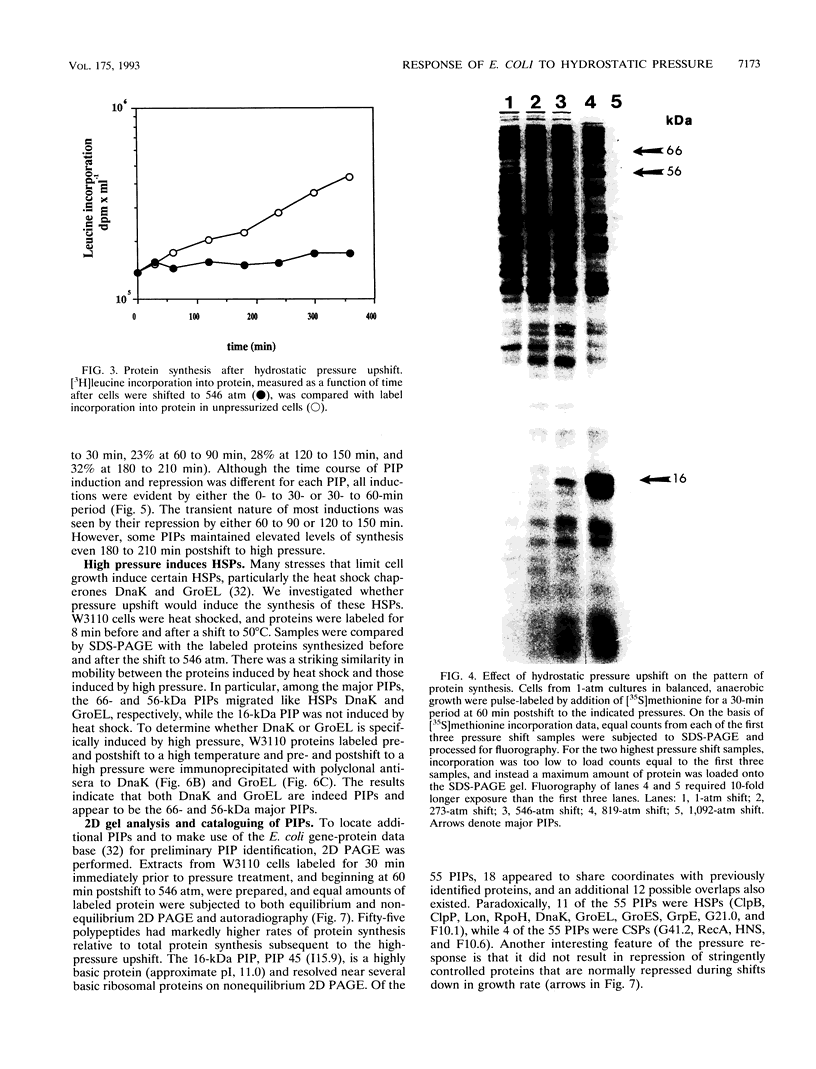
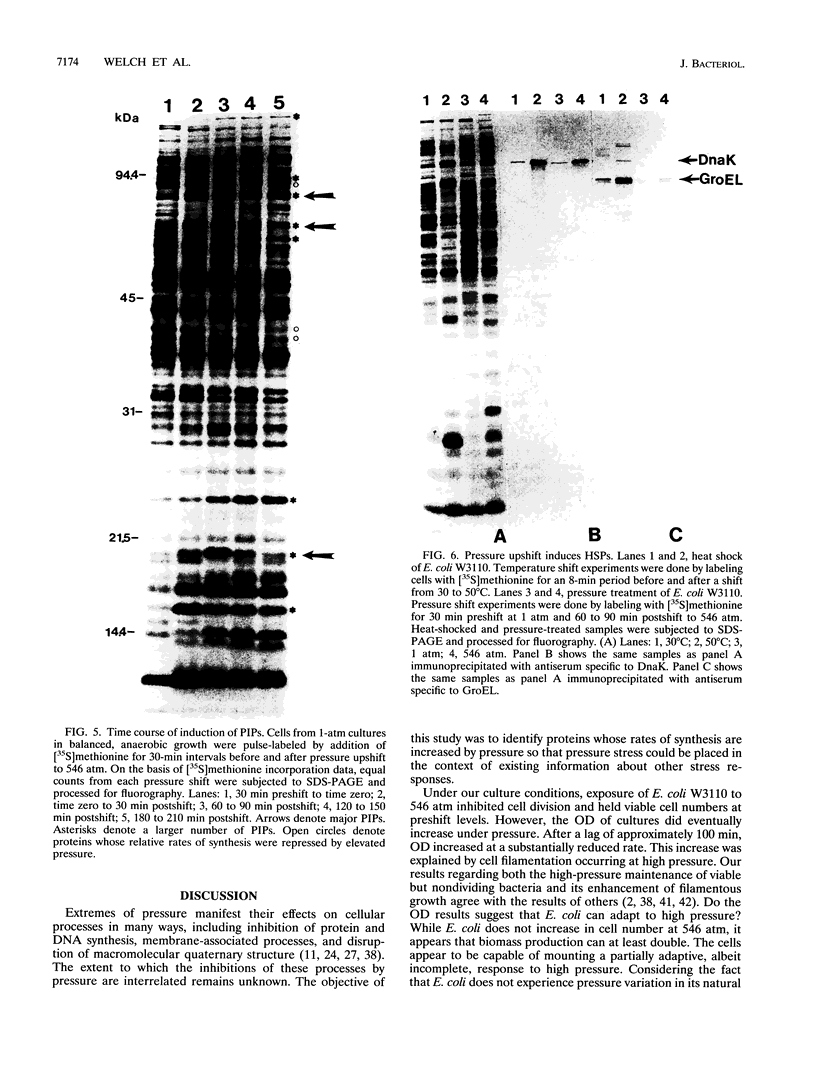
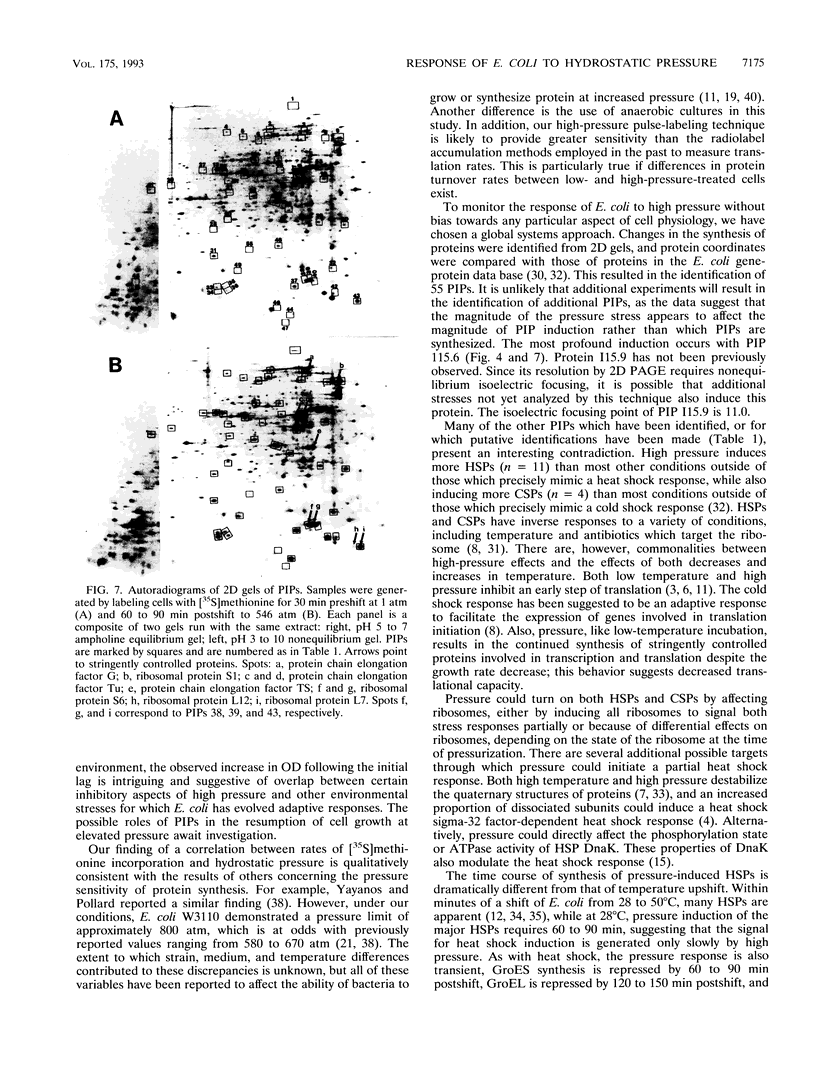
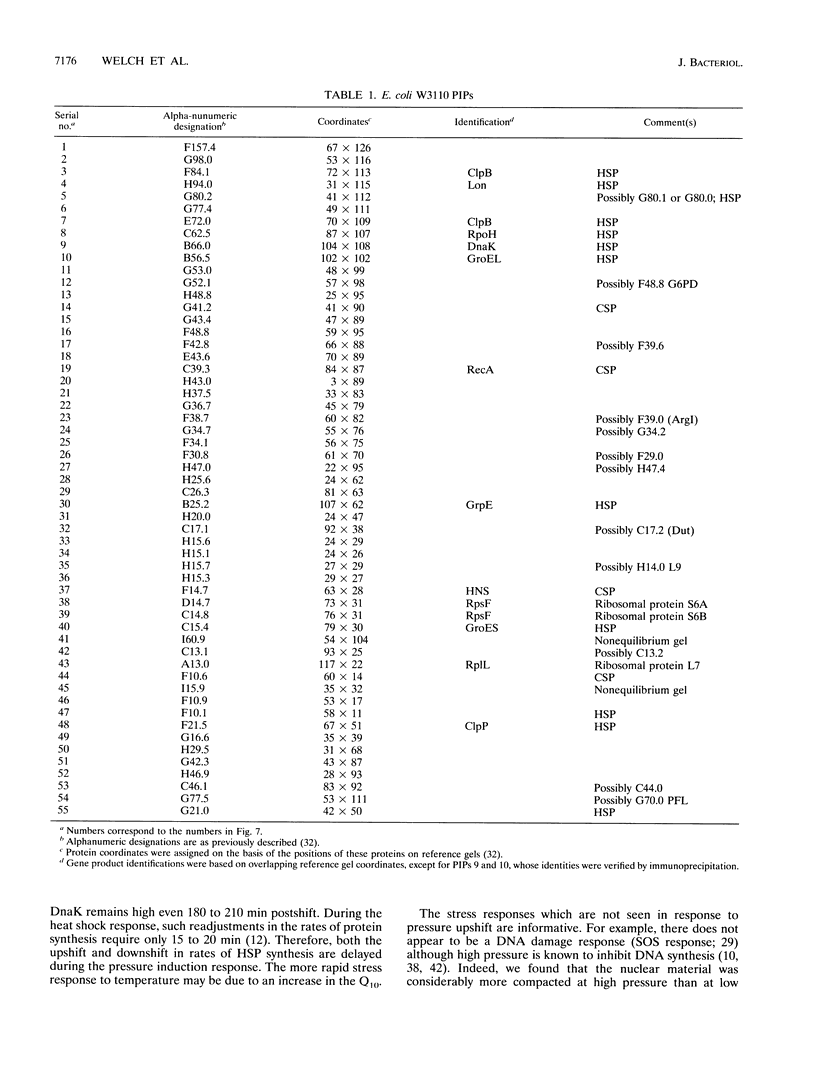
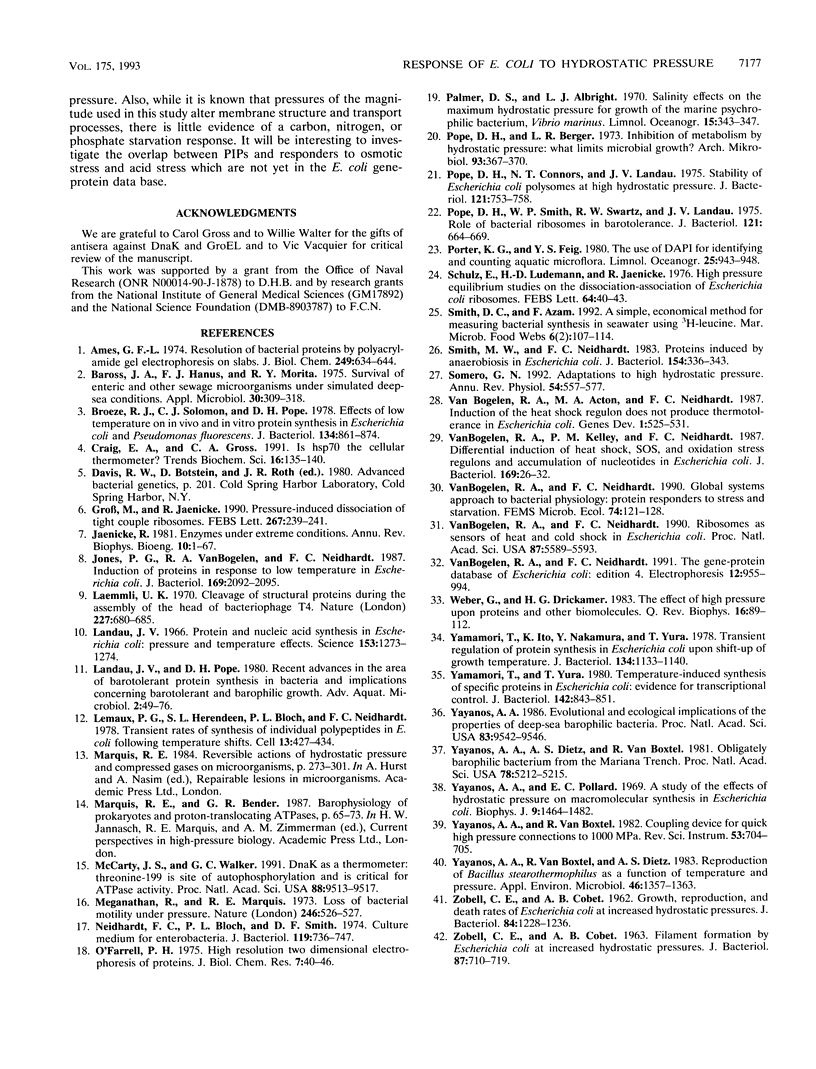
Images in this article
Selected References
These references are in PubMed. This may not be the complete list of references from this article.
- Ames G. F. Resolution of bacterial proteins by polyacrylamide gel electrophoresis on slabs. Membrane, soluble, and periplasmic fractions. J Biol Chem. 1974 Jan 25;249(2):634–644. [PubMed] [Google Scholar]
- Baross J. A., Hanus F. J., Morita R. Y. Survival of human enteric and other sewage microorganisms under simulated deep-sea conditions. Appl Microbiol. 1975 Aug;30(2):309–318. doi: 10.1128/am.30.2.309-318.1975. [DOI] [PMC free article] [PubMed] [Google Scholar]
- Broeze R. J., Solomon C. J., Pope D. H. Effects of low temperature on in vivo and in vitro protein synthesis in Escherichia coli and Pseudomonas fluorescens. J Bacteriol. 1978 Jun;134(3):861–874. doi: 10.1128/jb.134.3.861-874.1978. [DOI] [PMC free article] [PubMed] [Google Scholar]
- Craig E. A., Gross C. A. Is hsp70 the cellular thermometer? Trends Biochem Sci. 1991 Apr;16(4):135–140. doi: 10.1016/0968-0004(91)90055-z. [DOI] [PubMed] [Google Scholar]
- Gross M., Jaenicke R. Pressure-induced dissociation of tight couple ribosomes. FEBS Lett. 1990 Jul 16;267(2):239–241. doi: 10.1016/0014-5793(90)80934-b. [DOI] [PubMed] [Google Scholar]
- Jaenicke R. Enzymes under extremes of physical conditions. Annu Rev Biophys Bioeng. 1981;10:1–67. doi: 10.1146/annurev.bb.10.060181.000245. [DOI] [PubMed] [Google Scholar]
- Jones P. G., VanBogelen R. A., Neidhardt F. C. Induction of proteins in response to low temperature in Escherichia coli. J Bacteriol. 1987 May;169(5):2092–2095. doi: 10.1128/jb.169.5.2092-2095.1987. [DOI] [PMC free article] [PubMed] [Google Scholar]
- Laemmli U. K. Cleavage of structural proteins during the assembly of the head of bacteriophage T4. Nature. 1970 Aug 15;227(5259):680–685. doi: 10.1038/227680a0. [DOI] [PubMed] [Google Scholar]
- Landau J. V. Protein and nucleic acid synthesis in Escherichia coli: pressure and temperature effects. Science. 1966 Sep 9;153(3741):1273–1274. doi: 10.1126/science.153.3741.1273. [DOI] [PubMed] [Google Scholar]
- Lemaux P. G., Herendeen S. L., Bloch P. L., Neidhardt F. C. Transient rates of synthesis of individual polypeptides in E. coli following temperature shifts. Cell. 1978 Mar;13(3):427–434. doi: 10.1016/0092-8674(78)90317-3. [DOI] [PubMed] [Google Scholar]
- McCarty J. S., Walker G. C. DnaK as a thermometer: threonine-199 is site of autophosphorylation and is critical for ATPase activity. Proc Natl Acad Sci U S A. 1991 Nov 1;88(21):9513–9517. doi: 10.1073/pnas.88.21.9513. [DOI] [PMC free article] [PubMed] [Google Scholar]
- Meganathan R., Marquis R. E. Loss of bacterial motility under pressure. Nature. 1973 Dec 21;246(5434):525–527. doi: 10.1038/246525a0. [DOI] [PubMed] [Google Scholar]
- Neidhardt F. C., Bloch P. L., Smith D. F. Culture medium for enterobacteria. J Bacteriol. 1974 Sep;119(3):736–747. doi: 10.1128/jb.119.3.736-747.1974. [DOI] [PMC free article] [PubMed] [Google Scholar]
- Pope D. H., Berger L. R. Inhibition of metabolism by hydrostatic pressure: what limits microbial growth? Arch Mikrobiol. 1973 Nov 19;93(4):367–370. doi: 10.1007/BF00427933. [DOI] [PubMed] [Google Scholar]
- Pope D. H., Connors N. T., Landau J. V. Stability of Escherichia coli polysomes at high hydrostatic pressure. J Bacteriol. 1975 Mar;121(3):753–758. doi: 10.1128/jb.121.3.753-758.1975. [DOI] [PMC free article] [PubMed] [Google Scholar]
- Pope D. H., Smith W. P., Swartz R. W., Landau J. V. Role of bacterial ribosomes in barotolerance. J Bacteriol. 1975 Feb;121(2):664–669. doi: 10.1128/jb.121.2.664-669.1975. [DOI] [PMC free article] [PubMed] [Google Scholar]
- Schulz E., Lüdemann H. D., Jaenicke R. High pressure equilibrium studies on the dissociation-association of E. coli ribosomes. FEBS Lett. 1976 Apr 15;64(1):40–43. doi: 10.1016/0014-5793(76)80243-8. [DOI] [PubMed] [Google Scholar]
- Smith M. W., Neidhardt F. C. Proteins induced by anaerobiosis in Escherichia coli. J Bacteriol. 1983 Apr;154(1):336–343. doi: 10.1128/jb.154.1.336-343.1983. [DOI] [PMC free article] [PubMed] [Google Scholar]
- Somero G. N. Adaptations to high hydrostatic pressure. Annu Rev Physiol. 1992;54:557–577. doi: 10.1146/annurev.ph.54.030192.003013. [DOI] [PubMed] [Google Scholar]
- VanBogelen R. A., Acton M. A., Neidhardt F. C. Induction of the heat shock regulon does not produce thermotolerance in Escherichia coli. Genes Dev. 1987 Aug;1(6):525–531. doi: 10.1101/gad.1.6.525. [DOI] [PubMed] [Google Scholar]
- VanBogelen R. A., Kelley P. M., Neidhardt F. C. Differential induction of heat shock, SOS, and oxidation stress regulons and accumulation of nucleotides in Escherichia coli. J Bacteriol. 1987 Jan;169(1):26–32. doi: 10.1128/jb.169.1.26-32.1987. [DOI] [PMC free article] [PubMed] [Google Scholar]
- VanBogelen R. A., Neidhardt F. C. Ribosomes as sensors of heat and cold shock in Escherichia coli. Proc Natl Acad Sci U S A. 1990 Aug;87(15):5589–5593. doi: 10.1073/pnas.87.15.5589. [DOI] [PMC free article] [PubMed] [Google Scholar]
- VanBogelen R. A., Neidhardt F. C. The gene-protein database of Escherichia coli: edition 4. Electrophoresis. 1991 Nov;12(11):955–994. doi: 10.1002/elps.1150121114. [DOI] [PubMed] [Google Scholar]
- Weber G., Drickamer H. G. The effect of high pressure upon proteins and other biomolecules. Q Rev Biophys. 1983 Feb;16(1):89–112. doi: 10.1017/s0033583500004935. [DOI] [PubMed] [Google Scholar]
- Yamamori T., Ito K., Nakamura Y., Yura T. Transient regulation of protein synthesis in Escherichia coli upon shift-up of growth temperature. J Bacteriol. 1978 Jun;134(3):1133–1140. doi: 10.1128/jb.134.3.1133-1140.1978. [DOI] [PMC free article] [PubMed] [Google Scholar]
- Yamamori T., Yura T. Temperature-induced synthesis of specific proteins in Escherichia coli: evidence for transcriptional control. J Bacteriol. 1980 Jun;142(3):843–851. doi: 10.1128/jb.142.3.843-851.1980. [DOI] [PMC free article] [PubMed] [Google Scholar]
- Yayanos A. A., Dietz A. S., Van Boxtel R. Obligately barophilic bacterium from the Mariana trench. Proc Natl Acad Sci U S A. 1981 Aug;78(8):5212–5215. doi: 10.1073/pnas.78.8.5212. [DOI] [PMC free article] [PubMed] [Google Scholar]
- Yayanos A. A. Evolutional and ecological implications of the properties of deep-sea barophilic bacteria. Proc Natl Acad Sci U S A. 1986 Dec;83(24):9542–9546. doi: 10.1073/pnas.83.24.9542. [DOI] [PMC free article] [PubMed] [Google Scholar]
- Yayanos A. A., Pollard E. C. A study of the effects of hydrostatic pressure on macromolecular synthesis in Escherichia coli. Biophys J. 1969 Dec;9(12):1464–1482. doi: 10.1016/S0006-3495(69)86466-0. [DOI] [PMC free article] [PubMed] [Google Scholar]
- Yayanos A. A., Van Boxtel R., Dietz A. S. Reproduction of Bacillus stearothermophilus as a Function of Temperature and Pressure. Appl Environ Microbiol. 1983 Dec;46(6):1357–1363. doi: 10.1128/aem.46.6.1357-1363.1983. [DOI] [PMC free article] [PubMed] [Google Scholar]
- ZOBELL C. E., COBET A. B. FILAMENT FORMATION BY ESCHERICHIA COLI AT INCREASED HYDROSTATIC PRESSURES. J Bacteriol. 1964 Mar;87:710–719. doi: 10.1128/jb.87.3.710-719.1964. [DOI] [PMC free article] [PubMed] [Google Scholar]
- ZOBELL C. E., COBET A. B. Growth, reproduction, and death rates of Escherichia coli at increased hydrostatic pressures. J Bacteriol. 1962 Dec;84:1228–1236. doi: 10.1128/jb.84.6.1228-1236.1962. [DOI] [PMC free article] [PubMed] [Google Scholar]



